Why missing or bad Salesforce data makes everyone’s life miserable
To be successful, Marketing, Sales, and Customer Success strategies rely on good Salesforce data. Bad Salesforce data, on the other hand, can cripple business initiatives, and cause headaches for both your clients and internal employees.
Imagine creating an outbound sales cadence based on Job Title, but your Salesforce Org has Leads and Contacts that are missing Job Titles.
How about designing a marketing campaign based on location (such as a US State, Canadian Province, or a Country), but because your Salesforce Org uses text fields instead of validated picklist fields for this data, a high percentage of State and Countries are misspelled, or worse, missing completely?
It gets worse — dirty data could lead to negative interactions with customers (I thought they knew what I bought last year! I’m just data to them, and bad data at that!), and awkward conversations within sales teams (That was my Lead! No, it isn’t – it’s a duplicate! See? I own a Contact that already exists and I’ve been speaking with them for two weeks already!).
Now you have the worst of both worlds – upset customers and frustrated employees!
Rest assured — this article is here to help. While maintaining data quality might seem imposing up front, below I’ve outlined how to find and resolve data quality issues in your Salesforce Org with some relatively easy steps.
You can’t turn water into wine, but you can turn poor-quality data into high-quality data by implementing a few best practices around data hygiene.
Clean data is the ultimate goal, so let’s see how we can get there!
What is considered bad data hygiene?
We can all agree that bad Salesforce data is a problem. But before we can come up with solutions, we need to first define the problem. From a Salesforce perspective, bad data hygiene has a few different definitions.
While every company collects different Salesforce data and uses a different Salesforce data model, there are some fairly obvious (and not so obvious) Salesforce data you should collect.
But it isn’t that simple — you not only need to be collecting Salesforce data properly, but you also need to be establishing proper relationships between different Salesforce Data Objects (think Opportunities related to Contacts through Opportunity Contact Roles or Products related to Opportunities through Opportunity Products).
Hence data hygiene not only encompasses the proper entry, collection, and cleaning of dirty data, but also ensures you have proper data relationships.
Fear not! The good news is that if you know what you should be doing, you can then compare that to what you’re actually doing (or failing to do) and then put in data quality processes and standards to fix inaccurate data. The end result is clean data for your Salesforce Org and actionable data for your sales and marketing teams.
Step 1 – Salesforce Data Auditing
These are the main Salesforce data and Salesforce data relationships you need to audit before you can fix your bad Salesforce data. This is not an exhaustive list, but it will get you headed in the right direction.
Duplicate Accounts
First, you need to know how many of your Accounts are duplicates. Using Duplicate Management strategies, I create a Duplicate Accounts report type and review each potential duplicate. I then merge duplicate Accounts or rename them if they share the same name but are actually different Accounts.
The final option is to simply remove the duplicated Accounts completely from the Salesforce Org if it has no unique Salesforce data (if it did, you’d have merged it, right?).
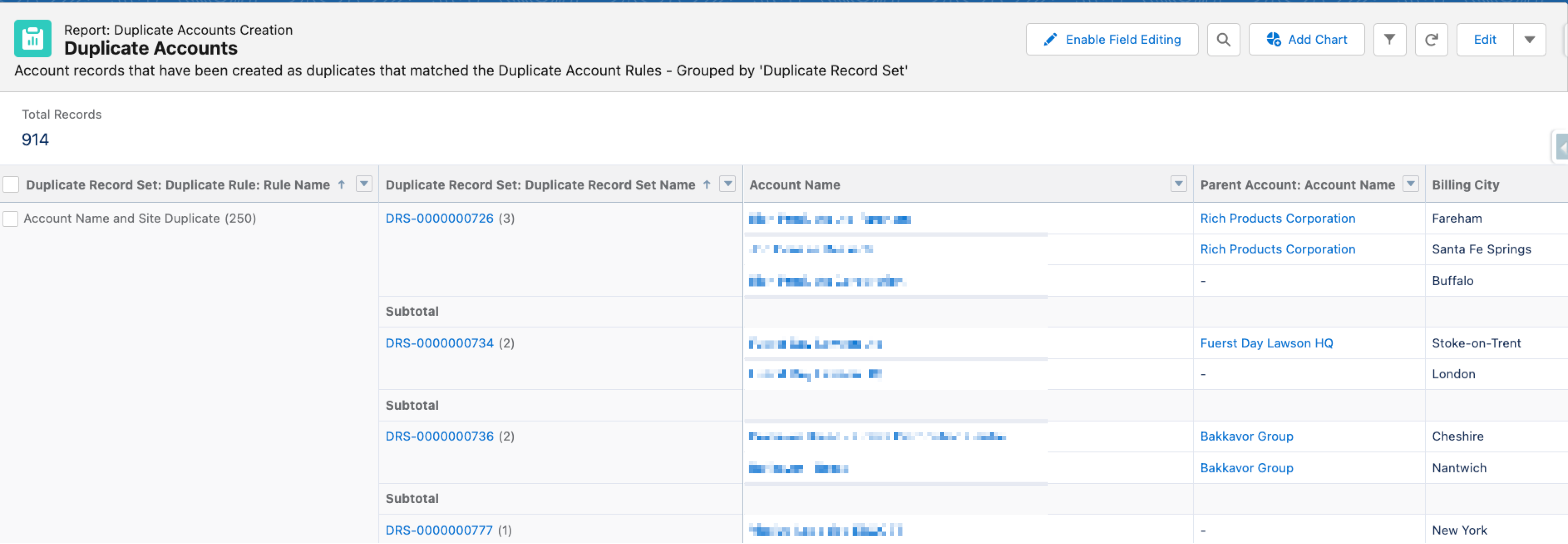
Duplicate Contacts
You also need to know how many of your Contacts are duplicates. A Contact could match an existing Contact (same email, for example), and it could also match an existing Lead. You should merge Contacts that are duplicates, and if you find a Lead that matches an existing Contact, convert that Lead and merge it with the existing Contact.
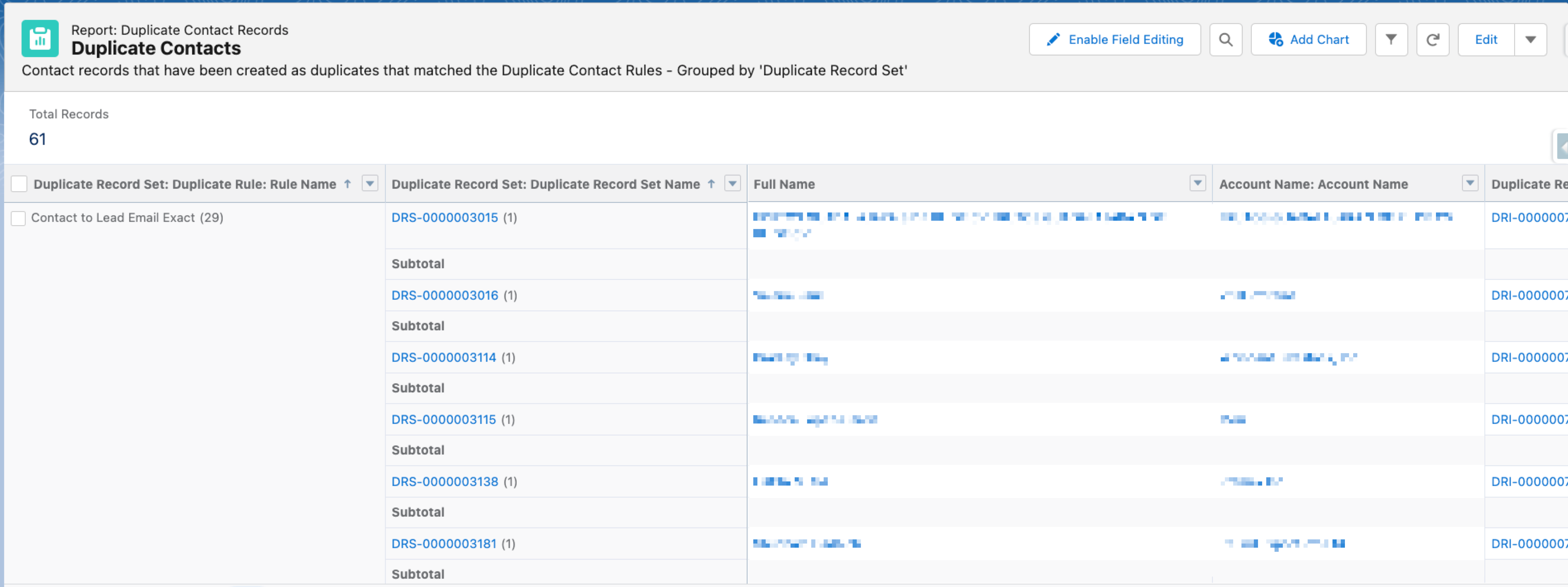
Duplicate Leads
Finally, you need to know how many of your Leads are duplicates. A Lead could match an existing Lead or an existing Contact. Merge Leads that are duplicates, and for the Leads that match existing Contacts, convert and then merge them via the Lead Conversion wizard.
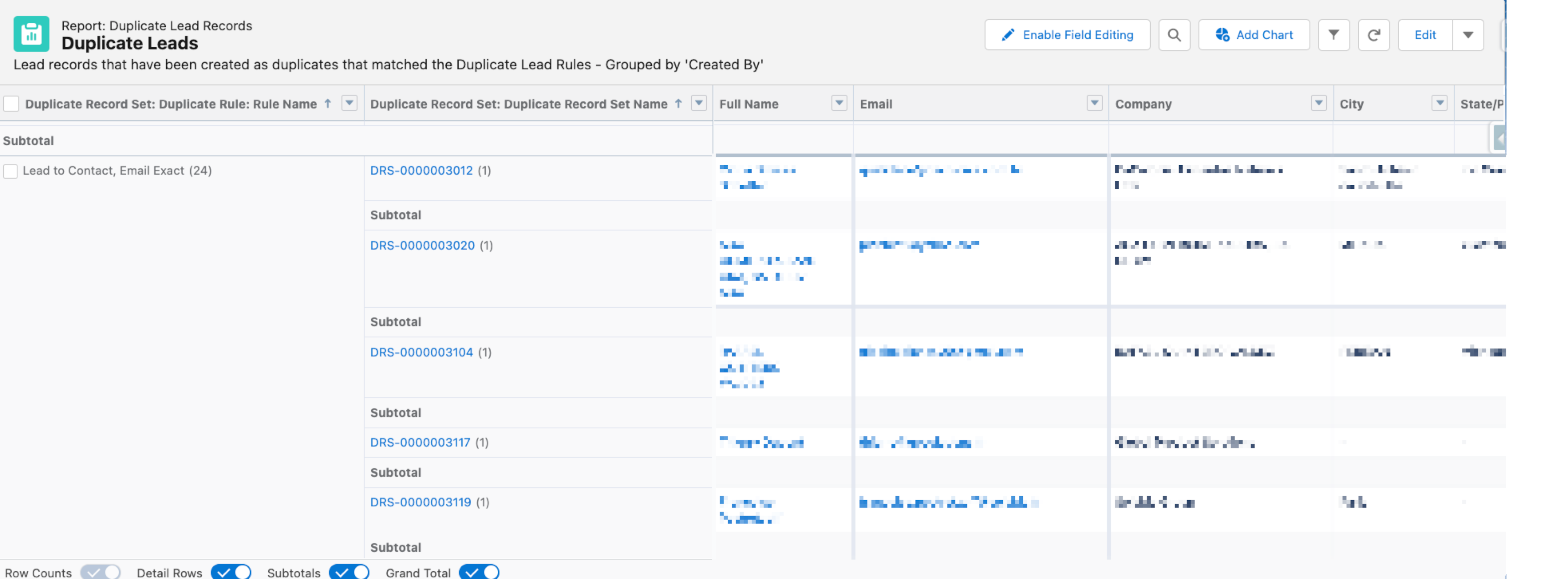
Leads and Contacts without Job Titles
If your marketing team is designing marketing campaigns around Job Titles (which they probably are doing already), blank Job Titles are going to render those campaigns ineffective. Not having a Job Title will also hinder the sales team’s ability to tailor their conversations and product offerings.
I recommend adding Job Titles manually if you have that data somewhere (in your emails with a Lead or Contact, for example), or use data cleansing tools such as ZoomInfo or Clearbit (there are many others, too) to add those Job Titles en masse.
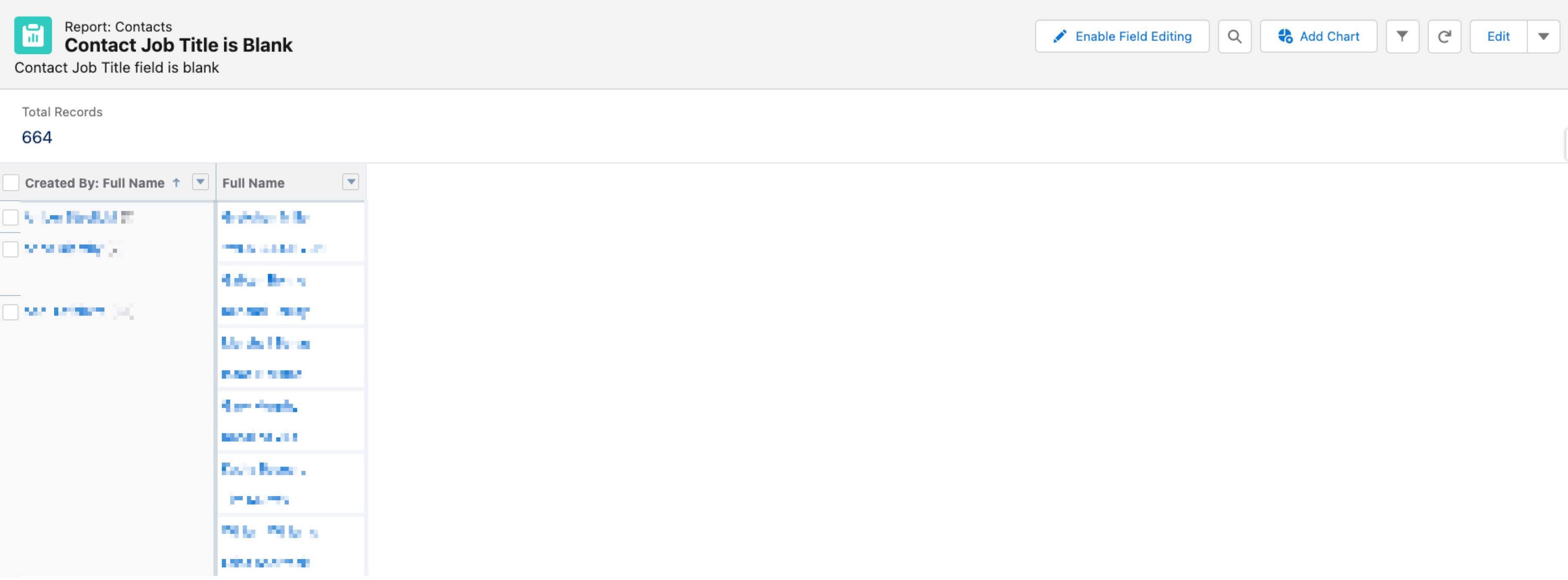
Leads and Contacts without Emails
This one is easy – you can’t communicate or market these days without an email.
Bad (Invalid) Emails: Even if you manage to collect email addresses for new leads, their validity is not guaranteed. And if you’re housing a lot of older data, there’s also a strong possibility that some of the email addresses you have in your database are no longer valid; people leave companies and change jobs all the time.
If your company uses a marketing automation tool, that validation process should be in place and ongoing (bounces are detected during each send), but if you’re uncertain about the validity of your email addresses, you can use a real-time email verification and email cleaning tool like ZeroBounce, NeverBounce, or BriteVerify. Some of these tools offer native integrations with Salesforce, allowing you to check the associated email address of every new lead you create and send back the returned result code in a custom field.
If you lose relationships you’ve built up over time due to a job change, check out User Gems (and other similar apps). It is an easier way to be alerted, and then manage job changes inside your Salesforce Org.
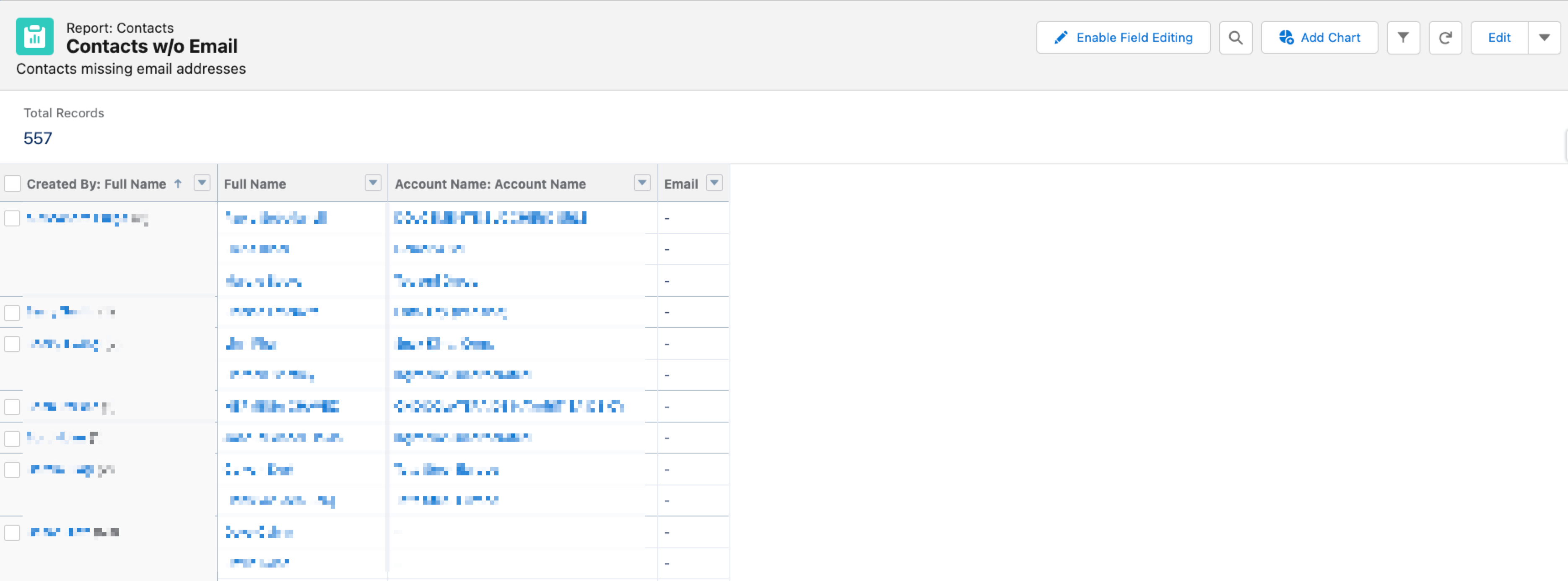
Leads and Contacts without Phone Numbers
Personally, I prefer that the brands that I love, and the people who sell me products that I use – simply use text to communicate with me. But cold calling and other strategies are also very effective if done properly.
Regardless, in order to be an effective communicator on all fronts, you’re going to need phone numbers (and possibly mailing addresses if you are sending out mailers).
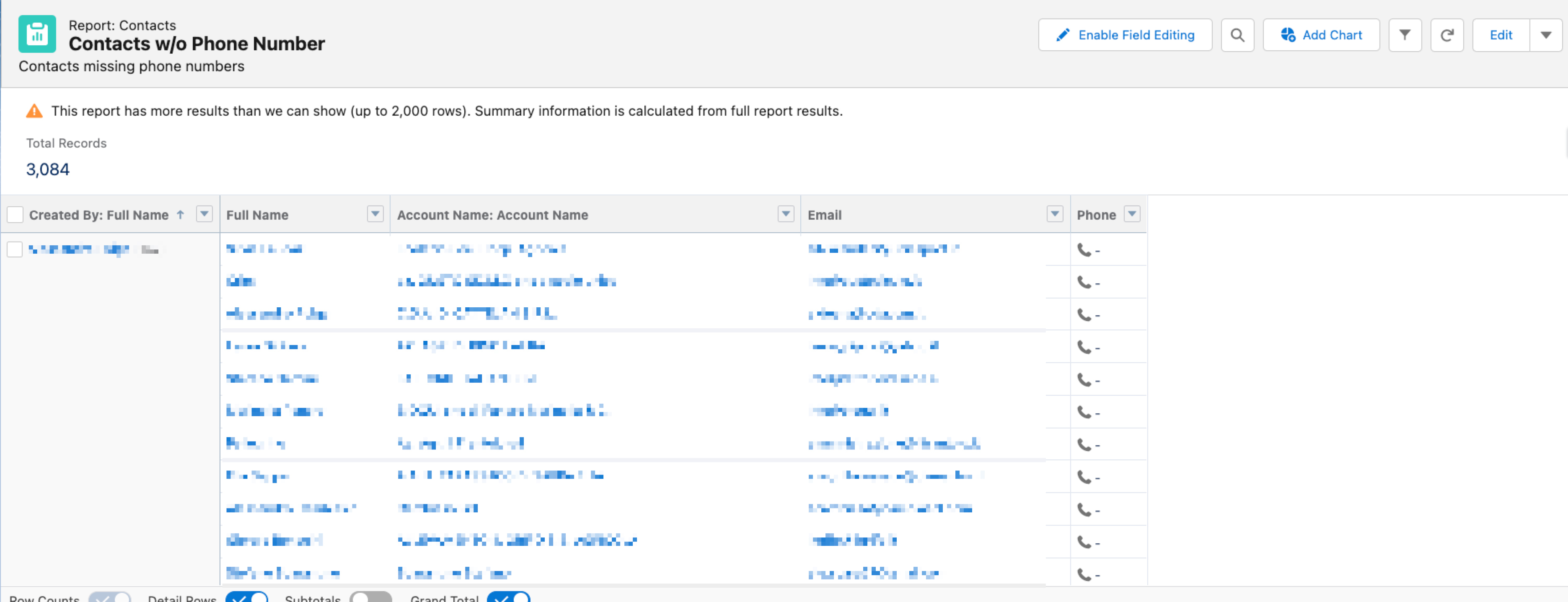
Opportunities without Contact Roles
If you are not using Opportunity Contact Roles, you will have serious Salesforce data gaps that will show up in marketing and sales initiatives.
Contact Roles on Opportunities are an out-of-the-box feature in Salesforce that establishes “all the people involved in my sale to this client.” For example, an Account could have one-hundred Contacts in Salesforce, but you are only working with two of them on a particular Opportunity (sale).
Contact Roles allow you, therefore, to establish the important decision-makers on individual deals. As a result of creating a relationship between the Opportunity and Contact(s), the marketing team can also now create more valuable segmentation lists because they will now know who specifically makes the decisions on particular deals, and what specific products or services they are interested in.
This important piece of data will lead to much more effective marketing campaigns.
However, none of this is possible if you are not adding Contact Roles to Opportunities. And there is an added difficulty – the relationship is not established out of the box when you manually create an Opportunity. However, if you create an Opportunity through a Lead Conversion, an Opportunity Contact Role should be created automatically for you.
Your Salesforce Administrator should write some validation that requires salespeople to establish a Contact Role if they are manually creating Opportunities.
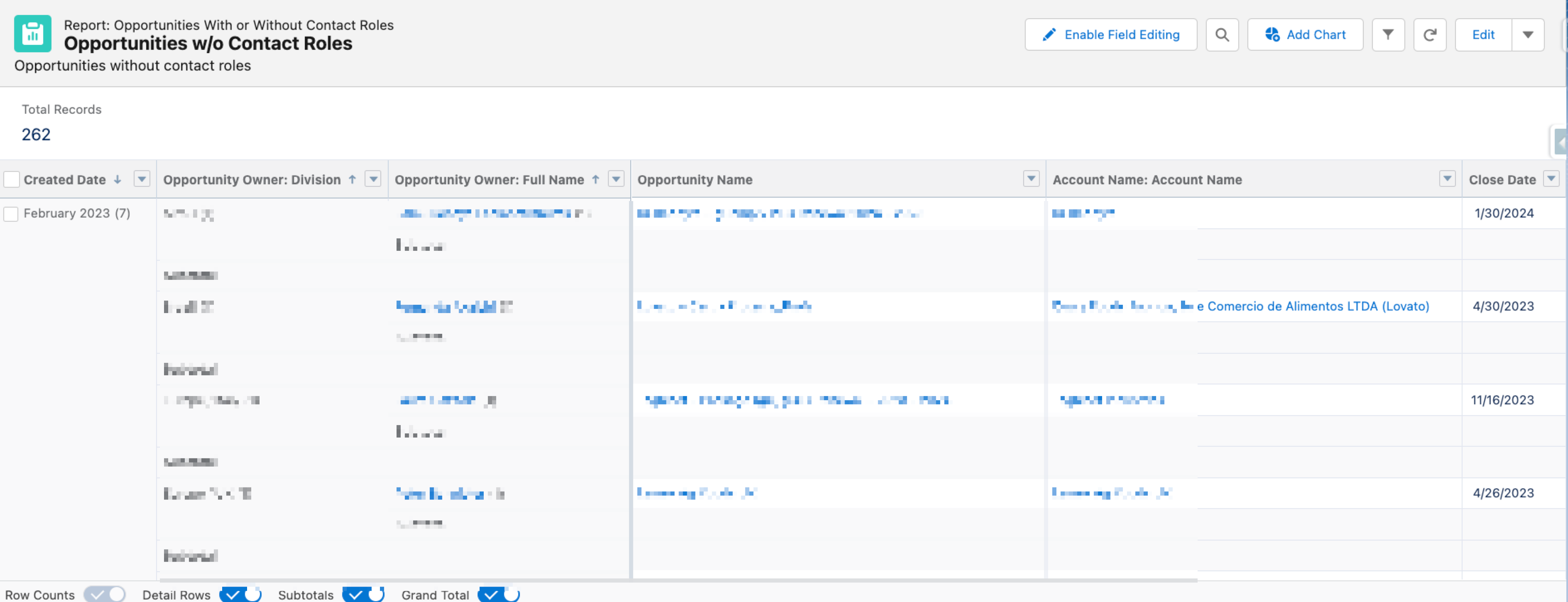
Opportunities without Opportunity Products
The prerequisite for using Opportunity Products is to have set up a Price Book (with Price Book Entries) in Salesforce. If you have not yet set up a Price Book, you need to.
Even if you only sell a few products, having a Price Book with a List Price (that can be changed on the Opportunity, if needed), is a very effective way to document what Products your clients are interested in, and what products you’ve sold them, and at what price.
With this valuable information in mind, Salespeople will always know what Products were sold in the past to clients and can therefore design a tailored upsell strategy, easily assist in renewing contracts, and – bringing it back again to the marketing team – marketing now has the ability to create more relevant product-specific campaigns.
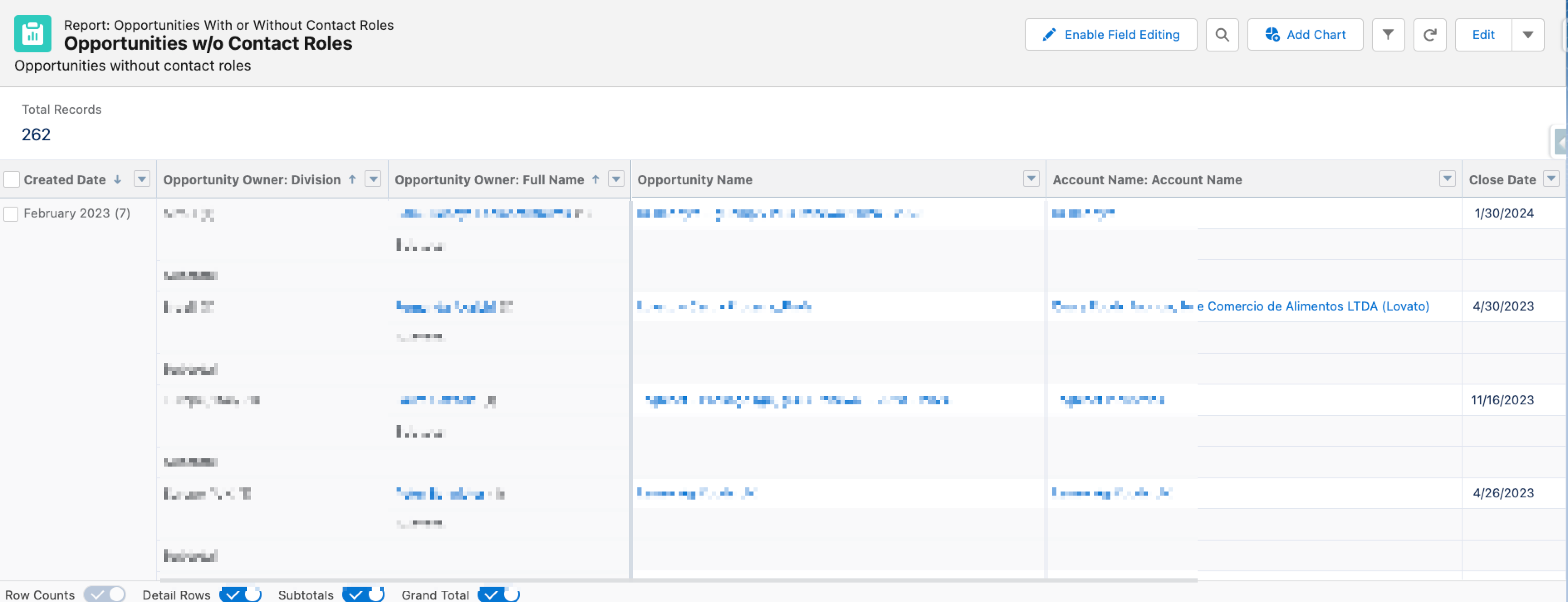
Opportunities without an Amount
Luckily, if you’ve been using Opportunity Products, the Amount field on the Opportunity will update automatically for you when you add a Product to it (assuming you’ve given that Product a List Price in the Price Book Entry).
If you haven’t been using Opportunity Products, then you could have a lot of Opportunities in your Salesforce Org that do not have Opportunity Amounts. Without an Opportunity Amount, it is impossible to understand the worth of your deal pipeline (open, won, lost), ROI of marketing campaigns, and disables any coherent forecasting strategy.

Accounts without a Website
If you collect a website, you have made the job of Salesforce data enrichment (whether people doing manual research for you and entering data into the account, or using a tool like ZoomInfo or Clearbit) much easier. Salesforce Data Enrichment automation tools often use Website URLs as one of the primary data points in order to properly enrich Account data.
And if you have someone doing research and data entry for you, it will save them a lot of time scrounging around the internet if you’ve set them up for success by collecting a website for them upfront.
You’ve also made it easier on your marketing or sales teams if they want to do additional research into individual Accounts in order to design their own tailored strategies.
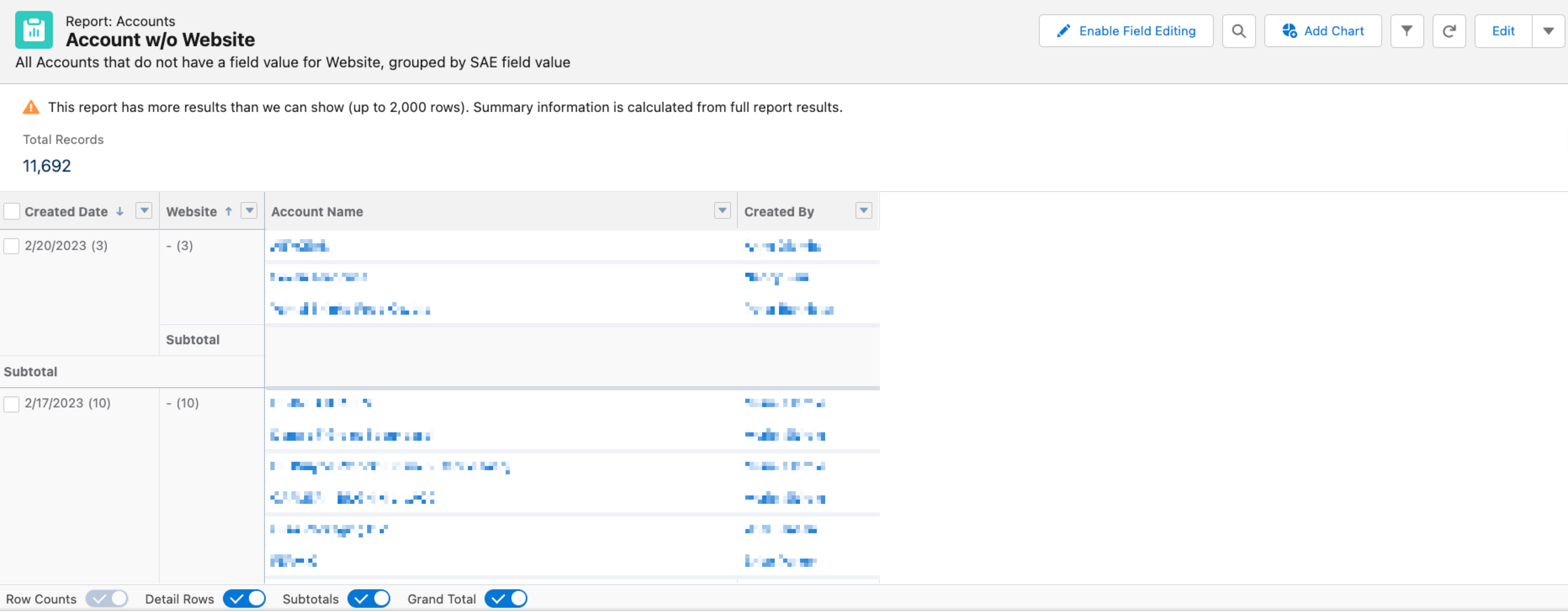
Accounts without an Address, City, State/Province, and/or Country
If you have geographic differences in the goods and services you provide, or if you have different lead assignment strategies in place for different regions of the country (or world), then not collecting location data will lead to a lot of marketing and sales frustration.
Your marketing team cannot design geographically appropriate campaigns, and individual salespeople might get assigned Accounts outside of their geographic territory and expertise.
Additionally, your accounting department won’t know what the Billing Address is, and if the marketing team is sending out mailers to a Mailing Address, they will also be at a loss.
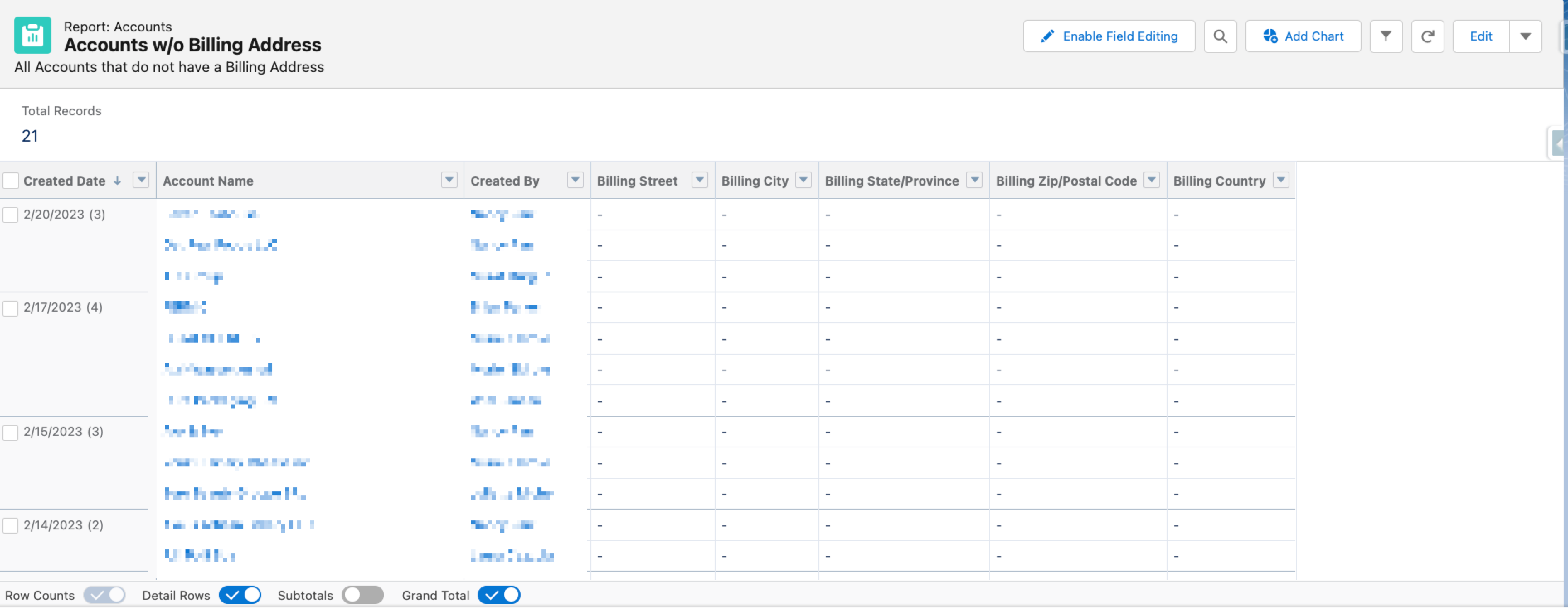
State and Country picklist fields have not been enabled
Out of the box, Salesforce uses Text fields, not Picklist fields, for “territories” such as States, Provinces, or Countries. Most people don’t recognize that they need to enable these picklists manually inside Salesforce.
Without validated picklists for these fields, standardizing Salesforce data is impossible; Salesforce users move fast and tend to accidentally misspell these various parts of the world making it impossible to create any automated segmentation based on location.
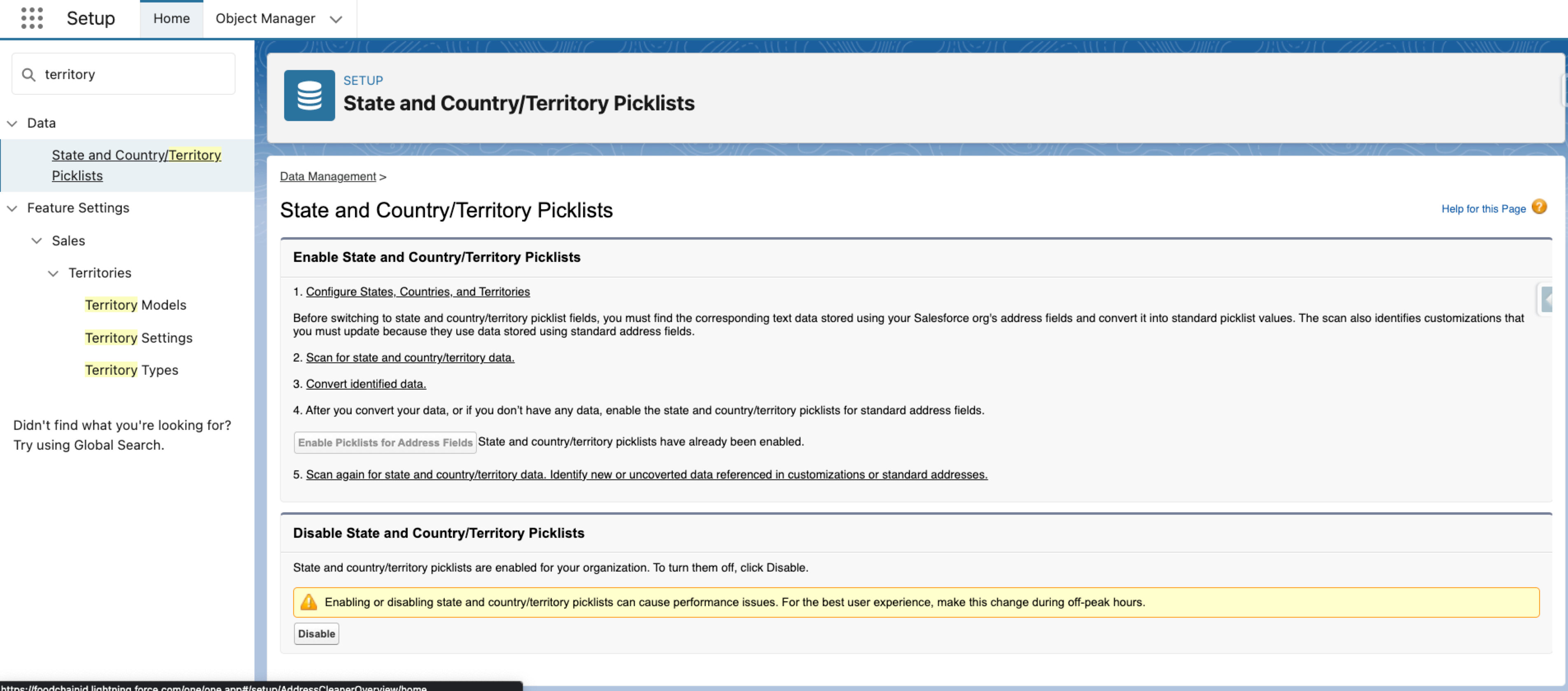
Monitoring Salesforce Data Hygiene with a Data Audit Dashboard
Now that you know what Salesforce data and Salesforce data relationships you need to monitor, you can create source reports for all the items listed above and add those source reports to a centralized Salesforce Data Hygiene dashboard.
A Salesforce Dashboard is a great way to monitor poor-quality data. The ultimate goal of this Salesforce Dashboard is simple — highlight existing dirty data so that you can take the necessary steps to fix inaccurate data and improve data quality.

How do you perform a Salesforce data cleanup?
Now that you know what you need to do, and you’re monitoring the current data quality state of your Salesforce Org, you can now actually do the cleanup job.
Relationships that were not established appropriately (like adding Contacts to the Opportunity via Contact Roles) can be established through historical data updates via Dataloader.io or the Data Import Wizard. You basically have to “work backward” in time and establish the necessary relationships that were not established in the first place.
Validation Rules are a very helpful solution to enforcing data entry on required fields and relationship establishment between Salesforce Objects to avoid future issues and repeating past mistakes.
Resolve the root causes by monitoring all data entry points
As you review the Data Audit Dashboard, you might notice some interesting behaviors at very specific data entry points. For example, you might notice a Salesforce User that often fails to remember to enter data properly, or a third-party integration that is creating duplicates without anyone realizing it.
Create a list of all possible data entry points and monitor them routinely to identify root causes and improve data quality at the source of the problem.
Train your team to apply data hygiene best practices for clean data
Aside from using Validation Rules and other processes (such as FLOW) to fix your data issues, all Salesforce Users should clearly understand the importance of data quality.
Bad data, missing data, or missing relationships between Objects lead to negative effects on the business as a whole. Data Quality is a systemic issue! Bad data will destroy the best of intentions! Reinforce this fact internally with all employees — no department is left unaffected by bad data quality in Salesforce.
Conduct regular data audits for optimal Salesforce data hygiene
Over time, the idea is to make monitoring and improving data quality a habitual process. Monitor your Salesforce Data Audit Dashboard routinely, and fix root causes and bad data.
As you come to understand your Salesforce Org better, you will most likely add additional items to your dashboard as you create new custom fields, develop new solutions to problems, and refine your sales and marketing strategies.
If you take these Salesforce data hygiene practices seriously, I guarantee your sales and marketing strategies will be more successful and your co-workers just might compare the miraculous work you’ve done to turn poor-quality data into high-quality data with other famous miracles! It isn’t water into wine, but you can still be a savior — saving your company from the debilitating effects of bad data.
Struggling with Salesforce data hygiene? Reach out and let us know.



